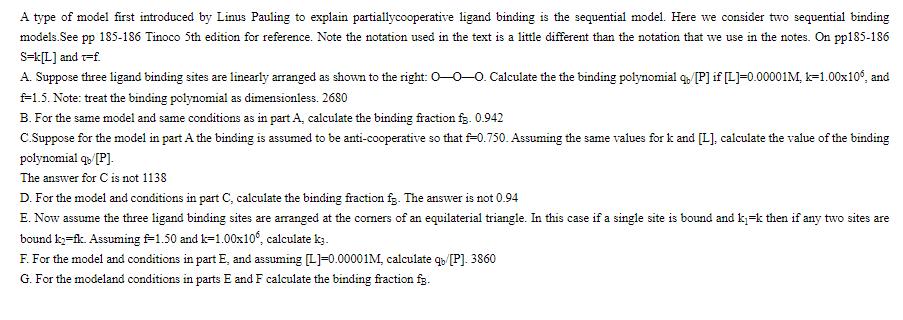Answered step by step
Verified Expert Solution
Question
1 Approved Answer
A type of model first introduced by Linus Pauling to explain partiallycooperative ligand binding is the sequential model. Here we consider two sequential binding

A type of model first introduced by Linus Pauling to explain partiallycooperative ligand binding is the sequential model. Here we consider two sequential binding models. See pp 185-186 Tinoco 5th edition for reference. Note the notation used in the text is a little different than the notation that we use in the notes. On pp185-186 S=k[L] and t=f A. Suppose three ligand binding sites are linearly arranged as shown to the right: 0-0-0. Calculate the the binding polynomial q/[P] if [L]=0.00001M, k=1.00x10, and f=1.5. Note: treat the binding polynomial as dimensionless. 2680 B. For the same model and same conditions as in part A, calculate the binding fraction fg. 0.942 C.Suppose for the model in part A the binding is assumed to be anti-cooperative so that f=0.750. Assuming the same values for k and [L], calculate the value of the binding polynomial q/[P]. The answer for C is not 1138 D. For the model and conditions in part C, calculate the binding fraction fg. The answer is not 0.94 E. Now assume the three ligand binding sites are arranged at the corners of an equilaterial triangle. In this case if a single site is bound and k-k then if any two sites are bound ky-fk. Assuming f=1.50 and k=1.00x106, calculate k3. F. For the model and conditions in part E, and assuming [L]=0.00001M, calculate qb/[P]. 3860 G. For the modeland conditions in parts E and F calculate the binding fraction f.
Step by Step Solution
There are 3 Steps involved in it
Step: 1

Get Instant Access to Expert-Tailored Solutions
See step-by-step solutions with expert insights and AI powered tools for academic success
Step: 2

Step: 3

Ace Your Homework with AI
Get the answers you need in no time with our AI-driven, step-by-step assistance
Get Started


